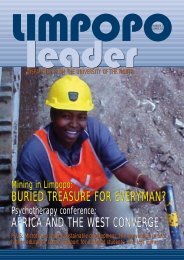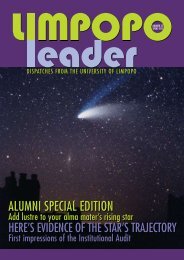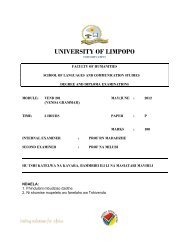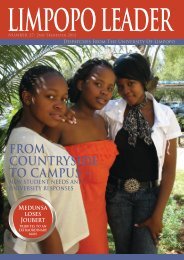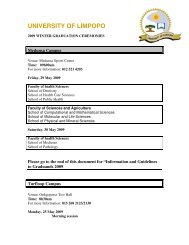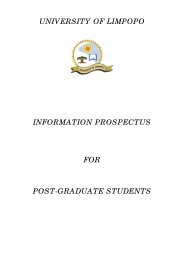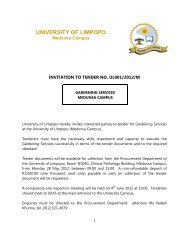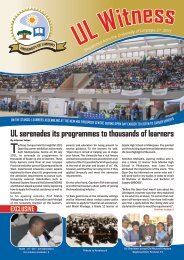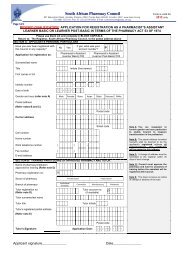Limpopo Leader - Spring 2005 - University of Limpopo
Limpopo Leader - Spring 2005 - University of Limpopo
Limpopo Leader - Spring 2005 - University of Limpopo
You also want an ePaper? Increase the reach of your titles
YUMPU automatically turns print PDFs into web optimized ePapers that Google loves.
Ophthalmology:<br />
CRASHING AEROPLANES AND<br />
HONG KONG RACEHORSES<br />
hHE’LL BE RETIRING IN A FEW YEARS – HE TURNS 63<br />
THIS NOVEMBER – BUT THE IMPACT OF HIS WORK<br />
AT MEDUNSA WILL LIVE ON AND ON.<br />
He’s Pr<strong>of</strong>essor Robert Stegman, ophthalmologist,<br />
whose work on the surgical treatment <strong>of</strong> cataracts<br />
and glaucoma has saved thousands from blindness.<br />
‘I came to Medunsa from Harvard <strong>University</strong>,’ he<br />
recalls. ‘I planned to stay for six months to do some<br />
trials. I’ve stayed for 27 years.’<br />
The trials were on a new substance that Stegman<br />
wanted to use in cataract operations. The South<br />
African Medicines Control Council had given its<br />
blessing. The substance was hyaluronic acid. It<br />
worked like a charm when it came to simplifying<br />
the implanting <strong>of</strong> intraocular lenses to counteract the<br />
degenerative effects <strong>of</strong> cataracts.<br />
But let’s go slowly with all these facts. Let’s start<br />
at the beginning.<br />
Stegman was born in Pretoria and did his first<br />
degree, as he says, at Tukkies. He then went to the<br />
United States, to Boston in fact, and in 1972 ‘gate<br />
crashed’ into Harvard Medical School where he<br />
specialised in ophthalmology. It was during his<br />
six-year stint at this most prestigious <strong>of</strong> American<br />
universities that his attention was directed to cataracts<br />
and their treatment.<br />
‘Intraocular lenses were just coming into their own,’<br />
Stegman explained. ‘It had been found during World<br />
War II that Royal Air Force crews experienced no<br />
major rejection symptoms from pieces <strong>of</strong> shattered<br />
cockpit windscreens that entered their eyes during<br />
combat or crashes. The windscreens were made <strong>of</strong><br />
Perspex (polymethylmethacrylate), and so medical<br />
scientists turned to this same material to manufacture<br />
intraocular lenses. But the first results were erratic,<br />
dogged with a lot <strong>of</strong> stability complications.<br />
‘Our idea at Harvard was to use hyaluronic acid.<br />
This was a naturally occurring material that lends<br />
substance or body to our tissues. It’s found in<br />
abundance in the combs <strong>of</strong> roosters: it’s what makes<br />
the combs stand upright. The acid had been<br />
discovered by a German scientist in the late 1930s,<br />
but a use for it was not found until 30 years later<br />
when it was tried, but with discouraging results, in<br />
a few retinal operations.<br />
Pr<strong>of</strong>essor Robert Stegman<br />
P A G E 1 1



